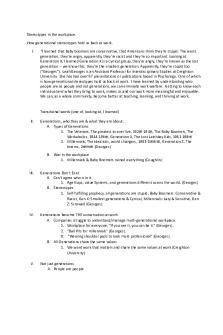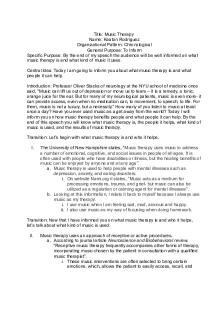HLTH1000 2021 A3 sheet informative PDF

| Title | HLTH1000 2021 A3 sheet informative |
|---|---|
| Course | Professions, People and Healthcare |
| Institution | University of Queensland |
| Pages | 4 |
| File Size | 161.1 KB |
| File Type | |
| Total Downloads | 65 |
| Total Views | 119 |
Summary
HLTH1000 2021 A3 sheet informative that is used to inform of information...
Description
HLTH1000 2021 A3
A3: Report Due date
Week 13, Friday, 29 Oct, 4pm
Weighting
30% Part A: Briefing document (800 words + 10%) In-text references are included in word count Part B: Infographic (200 words + 10%) In-text references are included in word count Respective word count limits apply for each part. A 10% penalty of the awarded mark will apply for not meeting requirements.
Learning objectives
3. Explain how Australia’s health system works 4. Develop an awareness of the principles of universal healthcare and how it is achieved globally
Task description This is an individual task. This assessment covers the online content from weeks seven to twelve. This includes universal healthcare and Australia’s healthcare system. From the course materials, you have learned that universal healthcare and health systems are interrelated. Universal healthcare (also known as universal health coverage) is an approach that underpins many health systems. It is championed by the World Health Organisation (WHO). Please review the sources cited in the online content as a starting point to help you identify relevant references you will need to answer each question correctly. You should include other references than those found in your online content. You will need to submit your assessment via the Turnitin portal in the Assessment tab. Please review the similarity rating to ensure you have paraphrased and referenced correctly. A high similarity does not necessarily mean that plagiarism has occurred. Reference lists, properly referenced quotes, and at times common tables of contents and headings can add to the Similarity Index. It is poor academic practice to have most of your work made up of large portions of “quotes” and little evidence of your critical thinking and synthesis of the knowledge. Good academic practice and scholarly research is about building on the ideas and work of others and informing the reader that you are acknowledging their work. Please refer to the Academic Integrity Modules https://www.uq.edu.au/integrity/ you would have completed for more information. A3 consists of two parts, Part A: Briefing document and Part B: Infographic. Please respond and structure your report around the two parts below:
HLTH1000 2021 A3
Prepare a briefing document for a visiting healthcare professional from another country to inform them about the factors identified by the World Health Organisation that define universal healthcare within Australia and their own country , and the differences and similarities between the health status of Australia and their own country as defined by the National Health Performance Framework’s ‘Health Status’ domain. The visiting healthcare professional is from one of the following countries. Choose ONE country of origin for the purpose of the assessment. a) Thailand b) Rwanda c) Brazil d) Mexico e) Bangladesh Part A – Briefing document (800 words) The briefing document should be structure as an essay: A brief introductory statement, the content you need to cover as below, and a brief concluding statement. The following five factors are needed for Universal Health Care as identified by the World Health Organisation. a) Efficient, well-run health system b) Affordability c) Availability of medicine and technology d) Health workers e) Actions to address social determinants of health Select two factors from the list above. Compare and contrast the application of two factors in the Australian healthcare system and the healthcare system of your chosen country. Use relevant indicators/components of the health system to inform each factor (e.g. affordability can be compared by referring household expenditure on health). Then explain how well these two factors are practised and the challenges to implementation in each country. NOTE: These are simplified; you will need to engage with the WHO material for a description of the factors (https://www.who.int/news-room/q-a-detail/q-a-universalhealth-coverage). Refer to other sources that will further support your response. You will need to do some additional research to discuss how these factors are practised in both countries. The Global Health Observatory provides health data that can support your work. https://www.who.int/data/gho/data/themes/universal-health-coverage You may like to review the following source to gain an overview of the topic, but you should refer to high-quality sources when developing your work (e.g., government, WHO, UN, AIHW, and peerreviewed sources): https://www.theguardian.com/society/2015/jan/06/-sp-universal-healthcare-the-affordable-dreamamartya-sen
HLTH1000 2021 A3
Part B – Infographic (200 words - accompanying written overview to be included at the bottom of infographic) Refer to the Australian Health Performance Framework: conceptual framework ‘Health Status’ domain. Compare the health status of Australia and your chosen country in an infographic. You must also provide a brief written overview which relates these comparisons to your discussion on the practice of universal healthcare in the two countries. Insert this overview at the bottom of your infographic. Your infographic should relate to two of the four dimensions within the health status domain (Refer to the yellow box on the right side of the framework): • Health Conditions • Human Function • Well-being • Deaths NOTE: Within those dimensions there are several aspects you can choose to represent in your infographic such as; life expectancy, the prevalence of a disease or mental well-being. The most important feature is that you can compare the two countries and use that comparison to underpin your relation to the practice of universal healthcare. The measures of performance you present must relate to the two factors you have chosen in part A The charts, graphs and tables you choose to present must not be digitally copied from other sources. When presenting data for the comparison you must produce your own charts, graphs and tables.
Infographic resources to guide your work: https://web.library.uq.edu.au/research-tools-techniques/digital-essentials/choosing-the-righttool/presenting-and-infographic-tools Access LinkedIn Learning LinkedIn Learning Course on creating an infographic in PowerPoint Introducing the 7 G.R.A.P.H.I.C. principles of public health infographic design. (Stones C, Gent M. Leeds: University of Leeds, 2016). You can use PowerPoint to create your infographic. However, many free sites may be helpful to create your poster quickly and effectively. For example: • Canva https://www.canva.com/ • Piktochart https://piktochart.com/ • Venngage https://venngage.com/ Note: some sites will require a subscription to download your designs. You can use any program to create your infographic that you feel most comfortable with but you need to download your infographic as a pdf, jpeg or png file and attach it with your briefing document for submission via Turnitin on Blackboard. You can embed the infographic within your briefing document in Microsoft Word. This can be done by inserting a picture file or screenshot. Ensure that your infographic is clearly visible for your tutor to assess.
HLTH1000 2021 A3
More information The essay is to be presented according to the following format: • 12 pt Arial font • 1.5 spacing • Use headings • Use full sentences (no dot points) • A reference list included at the end of your written components in the APA 6th style • Include the word count at the end of Part A and Part B (includes in-text references) • Ensure you have Part A and Part B There is no need for a cover sheet but please ensure that your student name, student number, tutor's name and tutorial group are clearly indicated. The marking criteria offers further insight into the requirements for each question please make sure you review it when completing this assessment.
A note about referencing This is about the clarity of communication and use of evidence (where appropriate to provide evidence for a point made, and acknowledged and referenced). For sources of evidence that have been referred to in the course materials, you need to consult those sources and provide the original reference details in your reference list. References are listed on the last page of the online content. Sources referred to outside of the course materials should be referenced in the usual way. All references must follow the APA 6th edition referencing style. The rule of thumb when using evidence: It is not solely based on how many references you use but the appropriate use of evidence to justify your claim and appropriate acknowledgement of sources you have cited. In APA style referencing the Reference List includes all cited references and occurs on a new page arranged alphabetically by author last name. Here is a link to the UQ Library APA 6th edition referencing style https://guides.library.uq.edu.au/referencing/apa6/reference-list...
Similar Free PDFs

Descargar A3 estudiants 2021
- 1 Pages

HLTH1000 Respiratory System
- 15 Pages

A3 - A3 nacirema
- 2 Pages

Formula Sheet 2021 - Formelblad
- 5 Pages

A3 CGAZ
- 7 Pages

A3 LJGJ
- 4 Pages

A3 RHLM
- 4 Pages

A3 - fsdfsd
- 2 Pages

A3 Geogebra
- 5 Pages

SGH Fact Sheet 2021-2022
- 8 Pages

Informative Speech
- 3 Pages

Informative speech
- 3 Pages
Popular Institutions
- Tinajero National High School - Annex
- Politeknik Caltex Riau
- Yokohama City University
- SGT University
- University of Al-Qadisiyah
- Divine Word College of Vigan
- Techniek College Rotterdam
- Universidade de Santiago
- Universiti Teknologi MARA Cawangan Johor Kampus Pasir Gudang
- Poltekkes Kemenkes Yogyakarta
- Baguio City National High School
- Colegio san marcos
- preparatoria uno
- Centro de Bachillerato Tecnológico Industrial y de Servicios No. 107
- Dalian Maritime University
- Quang Trung Secondary School
- Colegio Tecnológico en Informática
- Corporación Regional de Educación Superior
- Grupo CEDVA
- Dar Al Uloom University
- Centro de Estudios Preuniversitarios de la Universidad Nacional de Ingeniería
- 上智大学
- Aakash International School, Nuna Majara
- San Felipe Neri Catholic School
- Kang Chiao International School - New Taipei City
- Misamis Occidental National High School
- Institución Educativa Escuela Normal Juan Ladrilleros
- Kolehiyo ng Pantukan
- Batanes State College
- Instituto Continental
- Sekolah Menengah Kejuruan Kesehatan Kaltara (Tarakan)
- Colegio de La Inmaculada Concepcion - Cebu



